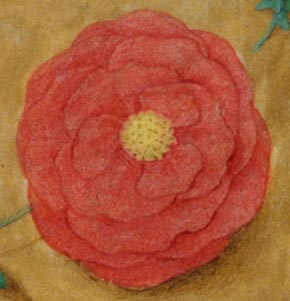Curator Christine Nelson honors the lovers who opened their hearts in the diaries now on view at the Morgan.

Detail from an illuminated border. Book of Hours, Netherlands, Utrecht, ca. 1500. MS G.5, fols. 18v–19. William S. Glazier Collection, given 1984.
I don’t doubt that Nathaniel was deeply in love (it was a month after his marriage to Sophia Peabody), but could his words have been colored by the fact that his wife was practically looking over his shoulder as he wrote? She had banished him to his study, he said, to make this entry in the diary they had agreed to keep together. He knew she would read his words later. This wasn’t the only time Nathaniel teased Sophia about her sunny disposition. The following year, as buds emerged and birds chirped and Sophia seemed in perfect sync with nature’s reawakening, Nathaniel exclaimed, “I have married the Spring—I am husband to the month of May!”
These lovers kept a diary for each other, an ongoing valentine that culminated in the pages I chose to display in The Diary: Sophia’s astonishing first-anniversary entry in which she told her husband that such milestones (including, presumably, Valentine’s Day) mean nothing to those who live in a state of perpetual bliss: “We have been in the free ranges of Eternity ever since we first recognized each other, & Time is beneath our feet.” Since we first recognized each other—what an extraordinary way to express that feeling of mutual accord that binds lovers and best friends!
Other lovers present in the exhibition did not feel so blessed. Fanny Grenfell, separated from her boyfriend by a disapproving family, kept a diary in the form of unsent love letters, pouring out page after page of extravagant pining. Adèle Hugo (Victor’s daughter) feigned pregnancy, faked a marriage announcement, and followed the unwilling Albert Pinson around the world while writing sheaves of diary entries. Aging writer Paul Horgan watched with disdain as self-absorbed hippies embraced on the streets of Aspen, but confided a secret regret to his diary: “in old age, love’s most pure self is the most clearly seen when it is most generally beyond reach.” And Tennessee Williams, despite proclaiming himself a “child of love” after having sex (twice) and listening to church bells clang in Barcelona, longed for deep and lasting companionship.

Manuscript diary of Charles Barrett, 1866–67. Purchased on the Acquisitions Fund, 1985.
With all this love and longing reverberating throughout the gallery, the diary that touches me most this Valentine’s Day is that of dear Charles Seliger, the gifted artist who died a year and a half ago, having entrusted his many, many volumes of diaries to the Morgan. I spent hours in our collection vault reading Charles’s thoughtful record of his varied and voracious reading and his insights about art and literature, but found myself in tears when I opened a volume he began in December 1975. Charles’s loyalty to his diary was such that even if he began writing in a volume that didn’t feel right, he stuck with it until it was full, and only then allowed himself to choose another notebook. But he made an exception that day in 1975. He felt his life was about to begin again, so he abandoned one notebook and began a fresh one. He made his first entry in it on the day he married Lenore Klebanow. “We are ourselves,” he wrote, “she is natural, no makeup, no hairdo, just herself, a reason enough to love her.” Like the Hawthornes, the newly-married Seligers celebrated the simple fact of having “recognized each other,” secure in the knowledge that being “just themselves” was enough.
Charles Seliger closed his wedding-day diary entry with this passage: “There is little else to write, for now what was and will be cannot be written. We left two houses this a.m. as two people, we met with our friends and before their eyes we became one—and it is that one, that very late this beautiful, holy night, drifted off the sleep, as the two innocents, now one, now two, to face the future and forever after.”
Happy Valentine’s Day.
Christine Nelson is the Morgan’s Drue Heinz Curator of Literary and Historical Manuscripts. All the diaries she mentions in this post are on view until May 22 in the exhibition The Diary: Three Centuries of Private Lives.
